In Part Two of The State and Future of Twitter, we reviewed Promoted Tweets and the new advertising platform and metric system that will test and hopefully strengthen the “interest graph” that connects individuals around relevant subject matter and eventually the ads that they might find relevant. In Part Three, we are going to review the news and ideas that erupted during the Chirp conference as well as the new features that position Twitter as “consumption media” and how it will earn new users and simultaneously increase the activity and contributions of everyone.
Twitter COO Dick Costolo defined Twitter as a consumption medium, “Millions of people might read tweets either on the site, through clients or through widgets on external sites, but they might not author tweets.”
If Twitter adheres to the Technographics or Socialgraphics analysis of Social Media, Costolo is not only correct, but also vocalizing what many researchers are leaning about social media: even though it provides a democratized platform for participation, most registered users of social networks read updates and content instead of updating or posting content. Therefore, one could deduce that social media is, for the time being, in a state of mass consumption and not mass creation.
Along those lines, two major announcements hit the Web during the Chirp conference related to mass content consumption.
The Library of Congress
As Twitter so cleverly titled its blog post, “Tweet Preservation,” it was announced that The Library of Congress deemed that the history of public tweets is worthy of preservation. There, the repository of conversations that defined a new medium, going back to the very first Tweet, will now reside at The Library of Congress.
To date, billions of Tweets have contributed to the evolution of online societies and the digital cultures that would inevitably impact our culture in the real world. From global celebrations to controversial elections to natural and heart-stopping catastrophes to local events and personal achievements, the archive of Tweets indeed represents a generation fueled by the “me” in social media. And, with every Tweet and ReTweet, human communications, the way we form relationships, and media itself was and continues to be redefined. Twitter has evolved into a lens into popular culture that not only reflects behavior, but also influences it.
As part of the contribution, The Library of Congress can only include Tweets in its internal library for non-commercial research, public display, and for preservation, after a six-month delay.
A few examples of important tweets that are now on display include the first-ever tweet from Twitter co-founder Jack Dorsey (http://twitter.com/jack/status/20), President Obama’s tweet about winning the 2008 election (http://twitter.com/barackobama/status/992176676), and a set of two tweets from a photojournalist who was arrested in Egypt and then freed because of a series of events set into motion by his use of Twitter (http://twitter.com/jamesbuck/status/786571964) and (http://twitter.com/jamesbuck/status/787167620).
Google Replay
Google paid to receive the full real-time Twitter firehose in December 2009 and since then it has expanded the feed to 40 languages and introduced a top links feature to help users find the most relevant content shared.
In conjunction with the announcement by The Library of Congress, Google announced Replay, a new feature that combines the public archive of Tweets with an interactive timeline that unlocks the history of conversations to revisit any point in time to discover, study, or reminisce.
Now you can zoom to any point in time and “replay” conversations that reflected sentiment and the state of conversation, steering perception with every Tweet. To replay history, run a search, click “Show options” on the search results page, then select “Updates.”
The first page reveals the most recent Tweets combined with a new chart at the top. The chart, in a sense, is a virtual time machine that allows you to specify the year, month or day, to view the tweets from any given point in time.
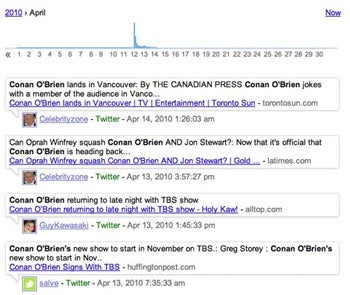
Twitter Search
Data already shows that searches within Social Networks are already rivaling traditional search engines in certain cases, with some major online destinations already reporting a majority of referral traffic stemming from social media over the biggest search engines.
At Chirp, Twitter reported that it fields roughly 19 billion search per month. Twitter co-founder Evan Williams also disclosed that Twitter performs 600 million queries per day, many of which are individuals searching for conversations containing their @ name I’m sure. However, neither number is easy to disregard.
Danny Sullivan, Editor-in-chief of Search Engine Land, dug a bit deeper to place these numbers into perspective to compare Twitter search to other traditional and social search activity. Using comScore numbers published in January 2010, Sullivan created a baseline using Twitter’s reported numbers:
Google: 88 billion per month
Twitter: 19 billion per month
Yahoo: 9.4 billion per month
Bing: 4.1 billion per month
We were initially surprised when YouTube consistently ranked behind Google, but ahead of all other search engine engines for total search queries performed each month. Looking at the numbers above, YouTube contributes to Google’s 88 billion total. But, according to Sullivan’s math, for total searches run on search properties, Twitter would technically rank ahead of Yahoo and behind Google.
Sullivan explains his caveats…
Now for the caveats. For one, we’re comparing Twitter’s self-reported figures to comScore’s estimated figures. To date, comScore hasn’t reported Twitter figures. Twitter doesn’t even register on the radar screen.
This is most likely because of the second caveat. Most of Twitter’s traffic isn’t happening at Twitter itself. Instead, it’s happening through API calls — a system for partners to send a search to Twitter and get the info back. Ratings services like comScore typically don’t include such queries, instead focusing on traffic they can monitor happening at specific web sites.
As Twitter continues to grow, so do its search numbers. During Chirp, Sullivan spoke with Twitter’s director of search Doug Cook. According to Cook, Twitter’s daily search queries have reached highs of 750 million and as he told Sullivan, Cook expects Twitter to channel 1 billion searches as soon as May 2010.
@Anywhere
As we discussed extensively over the years, one of the biggest hurdles contributing to troubling user acquisition and retention was the experience from the point of introduction, “follow us on Twitter” or the recommendation to do so and every click that forced users to manually visit Twitter, create accounts, and then somehow miraculously induce an epiphany about how to use Twitter as an everyday communication and discovery service.
To hopefully contribute to a more meaningful experience at inception, Twitter introduced @anywhere, which to quote Twitter, quoting Foursquare, makes Twitter “aggressively simple.”
@anywhere is a service designed to enable partner websites to easily integrate Twitter functionality into the site experience. Twitter’s idea or better said, hope, is that visitors to partner sites can then engage with existing Twitter features as well as hosted Twitter personalities, without having to leave.
Among the most cooperative examples for the @anywhere platform are of course, traditional media properties. In many ways, big media brands such as CNN, New York Times, MSNBC, et al, are finding their stories permeating the streams of Twitter users all over the world. Instead of indirectly benefiting from this activity, why not harness and thus, inspire it…direct, at the source.
News no longer breaks, it Tweets, and as Chloe Sladden, director of media partnerships at Twitter shared on stage, “@Anywhere is a way to shift a page view into a relationship.”
@Anywhere is a customizable platform (a few lines of JavaScript) that comes to life at the host site. In many ways, this is Twitter’s official answer to Facebook Connect, empowering visitors to engage with content at a host site, while simultaneously building a bridge between a user’s online activity and their respective social graph – triggering a social effect that ideally creates traffic between all affected properties.
The loved (if you’re on it) and hated recommended user list that greeted new Twitter users is on the way out in favor of an experience driven model, now placed squarely in the hands of those who ask us to “follow them on Twitter.” For example, if you as a visitor decide that you’d like to follow a particular reporter based on a story, you can do so on the spot and, you can also review a list a other reporters on Twitter who might write about content that you would prefer to follow.
Citysearch used @anywhere to help users get a complete real-time snapshot of a merchant and, when they’d like, engage that merchant via Twitter directly from CitySearch.com.
The Guardian uses @anywhere to connect readers with those running for public office. According to the UK publication, “Now, from within our pages you can ask questions your prospective parliamentary candidates and of our journalists. This is a clear indication of how we’re trying to lower barriers between our audience and those who hold power or seek to hold office, and between our readers and our journalists.”
The full list of sites using @anywhere include AdAge, Amazon, Bing, Citysearch, Digg, Disqus, eBay, Foursquare, Gawker, Google, Gowalla, The Guardian, The Huffington Post, Hunch, Mashable, Meebo, MSNBC.com, The New York Times, Salesforce.com, WSJ.com, Yahoo!, and YouTube.
Annotated Tweets
Ryan Sarver, Director of Platform of Twitter, announced that it now boasts over 100,000 registered apps…all the more reason for a service such as OneForty.com to help you. Note, I’m an advisor to the company, but the reason I’ve joined, is because of this information. With so many apps, we essentially need an app store for Twitter.
As 75% of Twitter’s traffic sources from external apps, Sarver expressed his gratitude and devotion. “Twitter is the way it is because of the ecosystem,” said Sarver. “There is no way we can be successful without you guys.”
Yes. The developer community did much more than “fill the holes,” the developer community stitched personal relevance and ambition into an otherwise ambiguous network. It is us who attracted mainstream attention. It is us who lured brands into the community. It is, in fact us, the users, who adopted these applications to help us use Twitter to learn, share, connect, and grow.
At Chirp, Twitter introduced what Robert Scoble might refer to as the “Super Tweet.” However, its name is a little less super, but these Tweets are rich with information.
Annotated Tweets, for developers, was perhaps the uppermost news to receive stage time.
Many refer to Annotated Tweets as “invisible hashtags,” but even that reference might not convey the capacity and potentiality of what it represents. When Chris Messina introduced the concept of hashtags, they were indeed, designed to integrate contextual references to each Tweet as well as for organizing and locating conversations as needed. However, Annotated Tweets, when they do officially launch within 60 days or so, will enable the incorporation of data behind data (metadata), beyond what’s already captured. This new Tweet framework will package and reveal the specific information that creative developers designate.
Twitter is a Global Phenomenon
Finally, I will share a bit of information that hit the Web one week prior to Chirp. I share this with you because I believe that Twitter and social networks overall, represent the bridges that make the world a much smaller place. When we think back to the contextual networks or interest graphs discussed in the earlier segments of this discussion, geography slowly dissipates. We are connected by the very things that captivate and inspire us and when we peer into a monitor we are essentially gazing into a window that looks upon a landscape populated by those we choose to follow and those who choose to follow us. We form a new information democracy that is representative of the stake in which we invest and nurture.
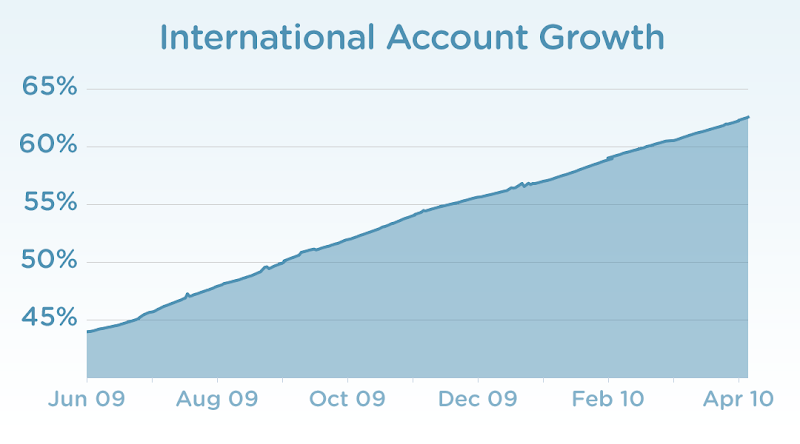
Twitter documented its growth as a “global information network” with a user base that’s geographically diverse. In fact, 60% of registered Twitter accounts live outside the United States.
Certainly, it’s a small world after all…
Previously: Part One – Twitter, by the numbers. Part Two – A review of Twitter’s new monetization strategies.
Connect with Brian Solis on Twitter, LinkedIn, Tumblr, Google Buzz, Facebook
—
Please consider reading my new book, Engage!

—
Get Putting the Public Back in Public Relations and The Conversation Prism:

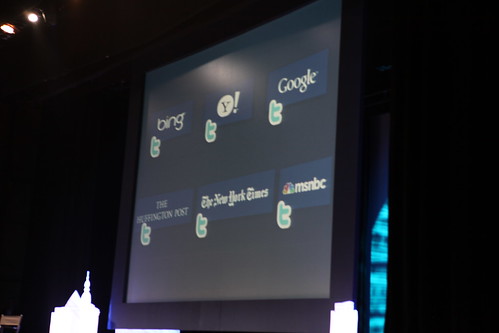
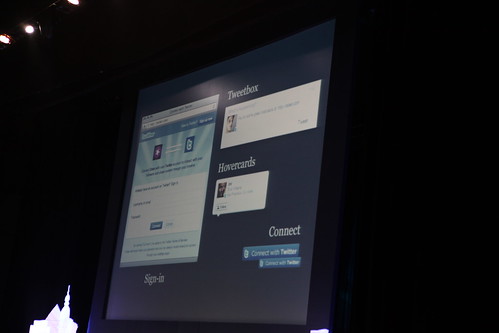



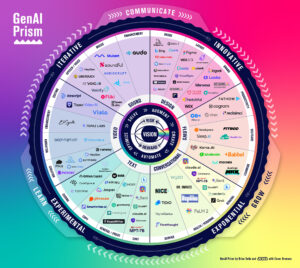



Wow, so much great stuff you covered Brian! I'm definitely going to mess with Google Replay. Also was very very surprised with how many searches Twitter gets and that it's actually beating out other search engines. Pretty amazing and something we should definitely keep an eye on.
Thanks Mike. So much information emerged during that conference, it took 3 parts!
Seems like with Facebook's f8 announcements, the 2 social networking giants are up for a big battle to make sense of the semantic web through Open Graph and @anywhere. Both are potentially injecting social into whole digital space.
Would that mean that we have to juggle both platforms in our day to day use or will we find different uses for each platform?
So glad these pieces were broken down into three. A great deal of information. Gutted about 'Replay' not being around when I wrote my dissertation, would have been a great help.
Brian,
Thanks your four your thoughtful multi-part reportage and analysis of Twitter. With Chirp and f8, it has been an amazing 10 days that shook the world. The most revolutionary aspect of each conference was the same: a substantial, then giant, step forward in the recognition of the import of metadata.
Twitter annotations could be powerfully informed if Twitter was to utilize Linked Data schema. For several days, their developers announced they would let the annotation classification system be determined by the market. Then, a ripple in the force: Facebook’s Open Graph – a partial implementation of RDFa.
As @StevenHodson pointed out today, Facebook’s “open” appellation may be illusory. While appreciating its simplicity, licensing and OAuth; @chrismessina also has reservations about the FB Open Graph protocol’s close-mindedness on identity providers http://bit.ly/atppdF and that it “depletes the ecosystem of potential and chaos,” which make tech “interesting and competitive” http://bit.ly/aEuTKC
I suspect Facebook’s Open Graph implementation will spur a cascade of interest in the exceptional values to be gleaned from implementing Linked Data schema and galvanize further investments in the early practical application of Tim Berners-Lee’s 1999 vision of a Semantic Web.
It is all about the metadata!
Wonderful article, thanks for putting this together! “This is obviously one great post. Thanks for the valuable information and insights you have so provided here. Keep it up!”
Dissertation Help | Custom Dissertation
Very curious as to how these annotated tweets are going to work. Thanks for the great post, Brian.
It is amazing to see how big Twitter has become and how everybody uses it. From famous people, politicians, regular people and even entrepreneurs. And they all use it for their own different purposes.
I still cannot believe the impact it has had on business, advertising and PR strategies. When business started using it at first, I must confess I didn’t believe this would work. But not only it did, but also it is becoming more and more popular everyday . Even to attract customers: http://startups.com/questions/29860/how-to-use-…
It is amazing!
Thanks for sharing all this info.
I can see why your head is spinning after this conference. There is so much coming, so much needed and so much possibility. This is an exciting time to be involved with Twitter. I can't wait for some of these things to come to life and let us realize the power that is still to be harnessed.
the twitter status will be zig-zagged, I'm sure of that
This page is simply enlightening and enjoyable to check out. I discovered a whole lot through discovering this. Thank you for putting up awesome written content and then keep up the excellent posting great stuff.
This page is simply enlightening and enjoyable to check out. I discovered a whole lot through discovering this. Thank you for putting up awesome written content and then keep up the excellent posting great stuff.
This page is simply enlightening and enjoyable to check out. I discovered a whole lot through discovering this. Thank you for putting up awesome written content and then keep up the excellent posting great stuff.
I am really curious to see how twitter monetizes itself in the future… Everyone wondered how FB would do it, and they are slowly making their way into Google’s territory of text ads. Curious to see what direction Twitter takes…
It’s hard to believe that twitter is still growing. It’s exiting to see that they’ll finally monetize it soon! I just watched the social network last night…Reminds me of their approach of waiting to sell ads until they hit critical mass.
webmaster
http://www.medicalinsurancefortravel.org
It would be truly revolutionary to have these
floating cities produce enough power to be self sufficient. Who
wouldn’t want to live in a city that can move to nicer weather or go to
interesting events around the world. Kind of like a slow moving cruise
ship. Very cool.
Thanks.
dissertation topics
This is really some awesome advice. Keep it up, my colleagues would love this.
Took a lot of time to read but I really found this very interesting and informative, thank you buddy for sharing.
Custom Logo Design
Stationary Design Services
Website Design Services
Banner Design Services
Brochure Design Services
Very curious as to how these annotated tweets are going to work. Thanks for the great post, Brian.
I could realize why your brain is actually mixing following this meeting.
There’s a lot on its way, a great deal necessary therefore a lot opportunity.
Twitter dominated the social networking platform prior to facebook but today facebook has more users than twitter I believe. Your article is worth reading.
Hi This one is great and is really a good post . I think it will help me a lot in the related stuff and is very much useful for me.